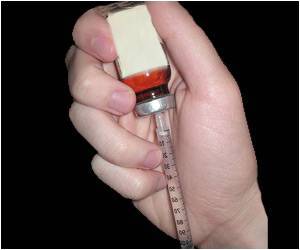A new study has revealed that influenza vaccination can help reduce the risk of blood clots forming in veins by 26 percent.
A new study has revealed that influenza vaccination can help reduce the risk of blood clots forming in veins by 26 percent
“Our study suggests for the first time that vaccination against influenza may reduce the risk of venous thrombotic embolism (VTE),” said Dr. Joseph Emmerich, lead author of the study and professor of vascular medicine at the University Paris Descartes and head of the INSERM Lab 765, which investigates thrombosis.“This protective effect was more pronounced before the age of 52 years,” he said while presenting the findings at the American Heart Association’s Scientific Sessions 2008.
VTE, the formation of a blood clot in a vein, is dangerous because the blood clot can break loose and travel through the circulatory system to the right side of the heart. It can further travel to the lungs, where it may prove to be life-threatening or even fatal.
For their research, the team conducted a case-control study among 1,454 age- and sex-matched patients (average age 52 years) from 11 centers in France (the FARIVE study).
The researchers compared 727 patients without personal history of cancer within the last five years who had initial episodes of VTE to a control group of age- and sex-matched patients free of venous and arterial thrombotic disease.
They revealed that patients younger than 18 years old — or those who already had VTE, had a diagnosis of active cancer or a history of malignancy less than five years previously, or had a short life expectancy due to other causes — were ineligible to participate in the study.
Advertisement
The patients were interviewed using a standardized questionnaire covering age, educational level, medication history, personal and familial history of thrombotic disease, and acquired risk factors for VTE, including pregnancy, use of oral contraceptives or estrogen replacement therapy, trauma or surgery less than three months previously, prolonged immobilization, or travel lasting more than five hours.
The researchers aid that the outcomes of the cases, documented through half-yearly telephonic interviews for five years, showed that the risk of developing VTE was lessened by 26 per cent after having the flu shot.
The study also showed that the protective effect of the flu shot was more pronounced before rather than after age 52 years, with a 48 per cent lower likelihood of VTE in those younger than 52.
In women under 51 years, the flu shot reduced the likelihood of developing VTE by 50 percent, and by 59 percent for women taking oral contraceptives.
The protective effect of vaccination was similar for different types of VTE—deep vein thrombosis or pulmonary embolism.
“Infections in general increase blood viscosity, and systemic inflammatory reactions to infectious agents can themselves trigger a thrombotic process. However, influenza vaccination might lower the risk of thrombosis in other ways, as suggested by the even distribution of VTE events across the 12 months of the year in both vaccinated and unvaccinated cases in our study,” Emmerich said.
He said that further studies were needed to confirm the relationship between influenza vaccination and VTE, and to explore the underlying mechanisms. It raises the possibility that flu vaccination could be recommended after a first VTE event, he added.
Source-ANI
LIN












